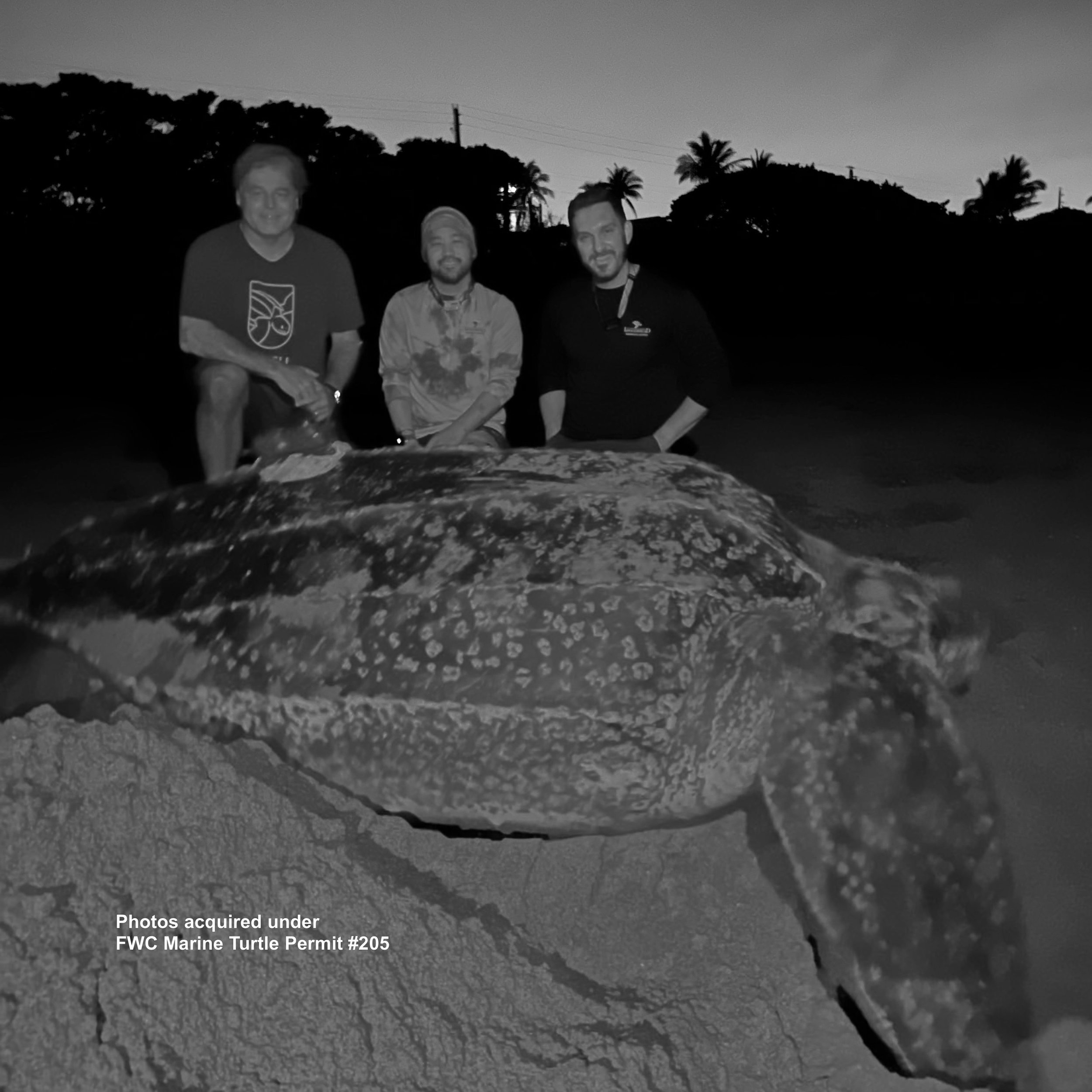Leatherback sea turtles are a highly migratory species and therefore incredibly hard for researchers to locate in their at-sea habitat. When female leatherbacks leave the ocean and crawl onto the beach to nest, it creates a unique opportunity for researchers to collect data and deploy satellite tags to learn more about these ocean giants. Leatherback nesting season in Florida lasts from approximately March to June, and throughout these months female leatherbacks will visit beaches in the area 5-7 times to lay eggs. At the beginning of June, Upwell Executive Director George Shillinger traveled to Juno and Jupiter beaches in Florida to catch the end of the leatherback nesting season monitoring conducted at the Loggerhead Marinelife Center (LMC) and participate in ongoing collaborative research projects.
Dr. George Shillinger, Derek Aoki, and Dr. Justin Perrault with Eunice, the 19th leatherback tagged in 2023. Photo acquired under FWC Marine Turtle Permit #205.
George worked with researchers from the LMC and Florida Atlantic University (FAU) Harbor Branch Oceanographic Institute (HBOI) to deploy two SMRU Satellite tags as part of a study on the movements, behaviors, and environmental preferences of internesting and post nesting West Atlantic leatherback turtles. In addition to the turtle’s location, these two tags have sensors that measure salinity and chlorophyll concentration in the water column, key information to help us understand leatherback habitat preferences as they dive and migrate. The tags are two of a total of twenty that have been deployed on nesting leatherbacks during the 2023 nesting season as part of this collaborative study.
George also supported the electronic tracking and monitoring component of Upwell Researcher Derek Aoki’s Ph.D. project being conducted in collaboration with Upwell at FAU Harbor Branch Oceanographic Institute with support from the LMC. This is Derek’s fifth nesting season conducting research, and though it requires long nights patrolling the beach and collecting data, he says,
Derek Aoki conducts research on Patricia the leatherback, photo by Nicole Carbajal. Photo acquired under FWC Marine Turtle Permit #205.
“Being able to monitor nesting leatherbacks is a privilege because it’s an experience very few people get to witness, and no two nights are the same. Each turtle we encounter is unique in her own way, and that is what makes this work so special. You never know who we will see, and even if they decide to nest at 4 am, it’s worth the sleepless nights knowing we are doing important research on the southeastern Florida nesting aggregation to understand their foraging ground locations and how they will respond to climate change.”
George shared his excitement about these projects, saying, “The satellite tracking data is yielding novel insights about the movements, behaviors, and environmental preferences of internesting and post nesting West Atlantic leatherback turtles. Our hope is that this data will expand our knowledge about leatherback life history, behavior, and movements, and inform future management and conservation strategies to protect leatherback turtles along the U.S. East Coast, in Canadian waters, and within high-use habitats in international waters and within areas beyond national jurisdiction (ABNJ).”
Meet some of the leatherbacks that researchers monitored on Juno and Jupiter beaches this season:
Photo by Derek Aoki. Photo acquired under FWC Marine Turtle Permit #205.
PATRICIA
Patricia was first encountered by the LMC team in 2005. She nested again in 2013 and they had not seen her again until this nesting season, when LMC researchers weighed her in at an impressive 1,316 pounds. Dr. Justin Perrault, LMC's Director of Research, noted upon seeing the massive turtle, "In the 1000 plus encounters I’ve had with these animals in my career, I rarely get those that are so big. It goes to show that nature never ceases to amaze and surprise."
Photo by Derek Aoki. Photo acquired under FWC Marine Turtle Permit #205.
SHIRLEEN
Shirleen returned to Jupiter beach to nest 5 times over the course of the nesting season.
Photo by Derek Aoki. Photo acquired under FWC Marine Turtle Permit #205.
SUMMER
Summer was first encountered in 2009, and nested 3 times over the course of the 2023 season. Summer was the official last turtle to be monitored during the LMC leatherback monitoring season, and was also the last turtle to receive a satellite tag from Upwell.
Photo by Derek Aoki. Photo acquired under FWC Marine Turtle Permit #205.
BEVERLY
Beverly was tagged by LMC in 2022 and subsequently migrated to Canadian waters off Nova Scotia to forage. When she returned to Florida to nest this season, researchers were able to replace her old satellite tag with a new one with the hope of obtaining information on consecutive migration cycles and to see if Beverley shows fidelity to northern foraging grounds.









Learn more about the work Upwell does to protect turtles at sea.